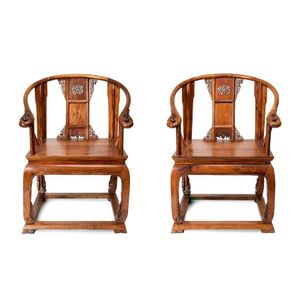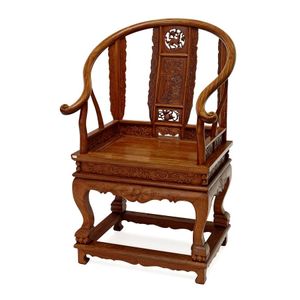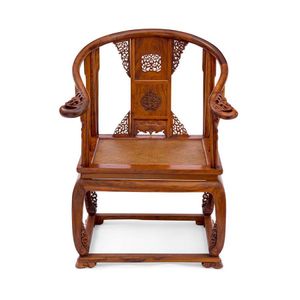Huanghuali Horseshoe-Back Armchair, Qing-style
A Huanghuali and hardwood Qing-style horseshoe-back armchair Quanyi, 19th/20th century, with a rounded crestrail set on straight front and back posts, flanked by shaped beaded edge spandrels and tapering side posts, the out-scrolled terminals carved with openwork foliate scrolls, the rectangular back splat enclosing a pierced foliate panel and dragon cartouche and flanked with similarly pierced spandrels, the rectangular mat seat within a mitred frame supported on four slightly curved square section legs on cloud-scroll feet with pierced spandrels above a platform base, 98 cm high, 57 cm wide, 64 cm deep, Compare with a zitan armchair dated to the early Qing Dynasty in the Palace Museum Collection, illustrated by Wang Shixiang, Classic Chinese Furniture, p 102 and 103, pl 56.
You must be a subscriber, and be logged in to view price and dealer details.
Subscribe Now to view actual auction price for this item
When you subscribe, you have the option of setting the currency in which to display prices to $Au, $US, $NZ or Stg.
This item has been sold, and the description, image and price are for reference purposes only.
- Zitan Wood - Zitan is the most expensive, and since ancient times, has been considered the most precious of woods.
Zitan wood is the hardest and heaviest of all hardwoods. It is purplish-black to black in colour, and with a grain so dense it is virtually invisible.
Zitan can usually only be obtained in quite narrow strips and so it is rare to find large pieces of furniture made from this wood. True Chinese rosewood is a variety of zitan and is very rare. - Ming Dynasty - The Ming Dynasty was a ruling dynasty of China from 1368 to 1644. It succeeded the Yuan Dynasty and preceded the Qing Dynasty. The Ming Dynasty was established by Zhu Yuanzhang, a former Buddhist monk who became a rebel leader and eventually overthrew the Mongol Yuan Dynasty. During the Ming Dynasty, China experienced a period of relative stability and prosperity. The government was centralized and bureaucratic, with the emperor at the top of the hierarchy. The Ming Dynasty is known for its cultural achievements, including the development of porcelain, the invention of movable type printing, and the construction of the Great Wall of China.
- Foliate - Decorated with leaves or leaf-like forms.
- Cartouche - An ornamental panel in the form of of a shield, oval or rectangular scroll with curling edges. It may be carved into the back of a chair or the top of a sideboard, or present on a piece of silver or jewellery, and contain the initials of the original owner, heraldic symbols, or some other inscription, such as the details of a presentation.
In ceramics the term defines the central area of a vase or similar with a decorative border in one of the shapes above, into which a decorative scene or figures have been painted. - Qing Dynasty - The Qing Dynasty was the last imperial dynasty of China, ruling from 1644 to 1912. It was established by the Manchu people, who originated from the northeastern region of China. The Qing Dynasty was preceded by the Ming Dynasty and followed by the Republic of China.
- Huanghuali Wood - Huanghuali is the most sought-after timber used in the construction of Chinese furniture because of its fine colour and grain.
During Ming and early Qing dynasties, most of the best furniture was made from huanghuali wood.
It is a member of the rosewood family and over time the surface mellows to a yellowish brown tone with the exposure to light.
In recent years, furniture made from huanghuali wood has increased exponentially in value.
This item has been included into following indexes:
- Chinese furniture, chairs
-
Chinese furniture, timbers
- huanghuali wood 159
- zitan wood 34
Visually similar items

A pair of Chinese Huali horseshoe-backed chairs. 97.5 cm high; 73 cm widest
Sold by
in
for
You can display prices in $Au, $US, $NZ or Stg.

Cedar apprentice dressing mirror, circa 1880, 26 cm
Sold by
in
for
You can display prices in $Au, $US, $NZ or Stg.

A Chinese horseshoe-back huanghuali chair, quanyi, 20th century 64.5 cm wide, 45 cm deep, 104 cm high
Sold by
in
for
You can display prices in $Au, $US, $NZ or Stg.

An occasional high back chair, probably Portuguese, 19th century, finely carved and pierced back with needle point tapestry upholstered seat
Sold by
in
for
You can display prices in $Au, $US, $NZ or Stg.
